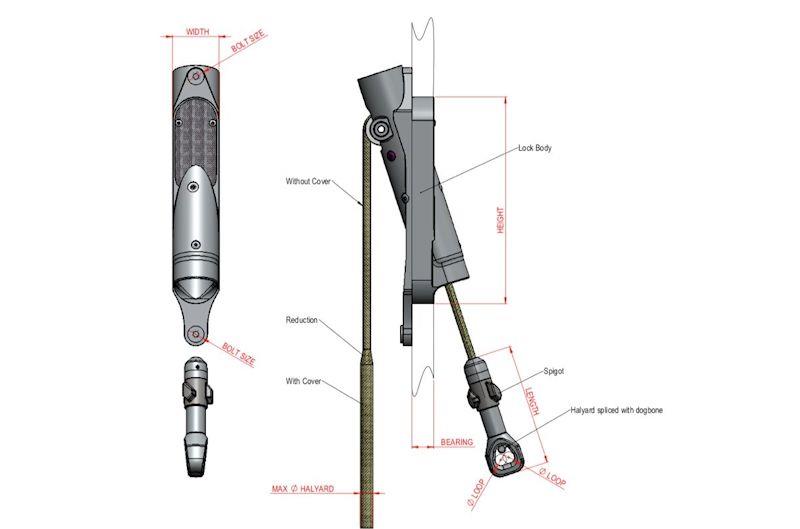
Nick Black Discusses Internal Headsail Locks
by Andy Rice, SailJuice 12 Oct 2018 08:00 UTC

Internal halyard lock © upffront.com
In our last article on locks we talked about the pros and cons of External versus Internal lock systems. Here we'll look more closely at the internal systems available, which tend to be aimed at the performance-oriented programs that are prepared to pay more for superior aerodynamics.
There are two main types of internal locking system:
1. Internal bullet
2. Tripless
Broadly speaking, if I'm asked to do the specs for an all-out race boat, I would almost always advise on going for the internal bullet. On the other hand, I think for performance cruising boats that do a bit of racing, it's a lot easier to have the tripless lock system.
Internal Bullet
The bullet basically goes up through the sheave and then locks on to a flipper. The bullet pushes the flipper out of the way, and as it goes past, the flipper springs back into position and the bullet just butts up against that. To unlock, there is a separate tripline that opens the flipper and allows the bullet to release. It sounds simple enough although in the past there have been reliability issues with the flippers and the springs could malfunction slightly which could then lead to the bullet getting jammed in the mast. Sometimes the bullet could also get caught sideways in the sheave box.
However, there has been massive improvement in the bullet design over the last decade or so, which means these problems have almost entirely gone away. You do occasionally get problems if someone overwinds something by accident and breaks the halyard; in which case the sail is going to be stuck up there and someone will have to go aloft to get it down. That's why I still tend to recommend the internal bullet only for high-end projects with professional sailors involved.
Tripless
With tripless, you hoist the lock mechanism into the lock, you reach a mark on your halyard and it automatically locks into position. To release, you hoist the halyard a few centimetres past the locking position until the mechanism releases, at which point you can lower the sail.
Facnor and Karver both offer tripless internal locks, although they vary slightly in how they function. Facnor do a hoisting bullet although most of the body lives externally on the mast so you can see what's going on. The Karver system operates around an O-ring system and three little triggers that basically flip in and out of position.
When to use
A lot of the race boat programmes prefer the flipper and bullet scenario because it's very positive and for them it's a very quick solution, and success with locking is probably close to 100 percent. The bullet system allows you to launch into the hoist at full speed, using first gear from the winch straight onto the lock because you've got a mark and you don't need to worry about it.
With the tripless versions you need to be a little bit more accurate with what you're doing. You can't just do everything at full speed, you might have to swap into second or third gear and be a little bit more careful about not over-winding the halyard. However, for a performance cruising boat where time and speed are not vital, simplicity of the tripless version is recommended because it requires less operation by the crew.
What does it cost?
If you were looking to retrofit your 60 to 80 footer with an internal bullet system, you'd probably be looking at more than 5000 Euros just for the mechanisms, plus another 2000 Euros or so for the installation process. External is a lot cheaper, but if you want the aerodynamic and performance benefits, then internal is the way to go.
If you have any questions about lock systems, then please feel free to contact us at or complete the Halyard Locks enquiry form.
About the authors
Co-owner of independent rigging company, Rigging Projects, Nick Black is one of the most sought-after riggers in the business. One way or another Nick's work has made its way into most of the top tiers of the sport - the America's Cup, Volvo Ocean Race, Vendée Globe, the grand prix circuits like the TP52s, and in the superyacht scene.
Andy Rice is a UK-Based European and National Title holder for various types of Racing boats. He started his career in yachting journalism in 1992, writing for Seahorse Magazine. Rice now works as a journalist and copywriter for many different clients and magazines. In between his Sailing Intelligence commitments, he still manages to write regular columns for Seahorse, ShowBoats International, Yachts & Yachting and Boat International.